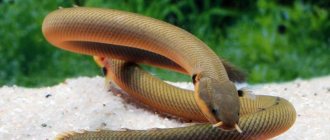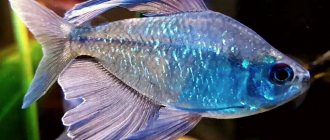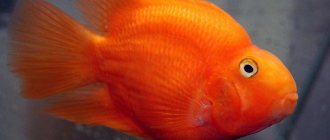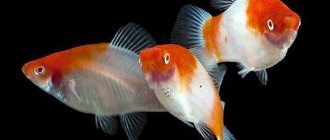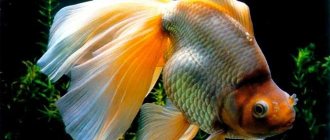author: fisher 02/26/2018 0 Comments
Family: Characinaceae
characinids
Tetra von Rio (Hyphessobrycon flammeus), also known as the fire tetra, is a cute little characin. Appearing in amateur aquariums in the twenties of the last century, it quickly became popular, along with ordinary neon and ternation. Unfortunately, today Tetra von Rio is a rare guest in amateur aquariums.
The genus Hifessobricon includes more than 40 species of small fish that live in the Amazon basin. All representatives of the genus lack scales at the base of the caudal fin.
The common name “ Tetra von Rio” is literally translated into Russian as “fish from the river.” The fish received its specific name due to its bright color (Latin flamma means “flame”). The species' habitat covers small rivers and streams in the vicinity of Rio de Janeiro (Brazil).
The fish is not large, its size usually does not exceed 4.5 cm.
Tetra von Rio
The predominant color is brown-olive. The front part of the body is silvery, sometimes with a yellow tint. Behind the head there are 2-3 vertical dark stripes that do not reach the back and abdomen. From the dorsal to the root of the caudal fin, the body is colored red, from pale pink to bright red. The fins are colored the same color, except for the transparent pectoral and fat ones. Along the edge of the fins there is a narrow dark edging, which becomes coal black during the spawning period.
The coloring is greatly influenced by the surrounding environment and the state of the fish at the current time. In optimal conditions, with overhead lighting, they are bright and beautiful; with the slightest fright and unsuitable housing conditions, the color of the fish fades, losing a significant part of its attractiveness.
In some reservoirs also located in the vicinity of Rio de Janeiro, a close species of the von Rio tetra - the Grima tetra (Hyphessobiycon griemi Hoedeman, 1957), or as it is also called the mirror tetra. It is somewhat smaller than the first: its maximum length usually does not exceed 3.5 cm.
As for coloration, one of the most significant differences is the dark pattern behind the gill covers. In the von Rio tetra it has the form of vertical stripes, while in the Grima tetra there is a spot in this place.
Both species interbreed without problems. Moreover, in first-generation hybrids there is a clear effect of heterosis (when the offspring exceeds the parents in size, vitality, color, etc.).
Today, finding a pure line of Tetra von Rio in Russia is quite problematic. It is easier to order a batch from natural biotopes, but there is no point in doing this, since there is unfortunately no interest in this species.
Description
Tetra von Rio has the typical quadrangular body shape of a tetra and belongs to the characin family. These aquarium fish typically reach 4 cm in length and live for about 3 to 5 years.
The front part of the body of this fish is silver, turning into fiery red on the back and especially at the base of the fins. Behind the gills, two black stripes stretch from top to bottom, and there is a blue ring around the eyes. Males have a blood-red anal fin; females have a lighter, sometimes yellow, fin. Only females have a black tip on the pectoral fin.
Tetra Von Rio is a very hardy fish, so it is perfect as a first aquarium fish for novice aquarists. However, despite the extreme hardiness of this species, the water in the aquarium must be carefully kept clean, as red tetras are susceptible to ich and other infections. This fish is also suitable for beginners who want to start breeding spawning fish.
Distribution : South America. In the estuarine zones of rivers in Eastern Brazil (Rio de Janeiro state). They stay in rivers and streams with weak currents.
Description : The color of the head and the front part of the body up to the dorsal fin is silver, the back part of the body and fins are colored reddish. The bases of the fins are colored in a particularly bright, fiery red color. On the sides in the front of the body there are 2-3 short black vertical stripes. There is a luminous ring around the eyes. Dimensions: Reaches 4 cm in length.
Feeding/types of food : Omnivorous. Usually they consume all types of live and dry food. You can feed several times a day with the amount of food that will be eaten in 3 minutes or less.
Water parameters:
- Temperature 23-28 C
- Acidity (pH) 6.5 to 7.0
- Hardness (dH) 3-15
Minimum aquarium size : 40 liters. It will be suitable for keeping a small school of these fish.
Social Behavior : Peaceful, recommended for community aquariums. It stays in all layers of water and does not damage plants. It is better to keep a group of at least 6 fish. Neighbors should be calm - some viviparous, zebrafish, rasboras, others tetras and peaceful bottom fish.
Sexual differences : Males have a blood-red anal fin. In females it is lighter, sometimes yellowish. Also, in females, the tips of the pectoral fins are colored black.
Reproduction
This type of fish reproduces relatively easily and generally presents no difficulties.
Before spawning, the spawners are seated and fed generously for a week. As a spawning aquarium, choose an aquarium with a volume of 4-10 liters, on the bottom of which a separator mesh is placed.
The water in the spawning aquarium must meet the following requirements: temperature 24°C, dH 10°, pH 6.5 (boiled tap water).
Java moss is placed in the aquarium, which will serve as a substrate for spawning, and in the evening the breeders are placed in the proportion of 2-3 males to 1 female. Fish begin to spawn in the morning the next day. One female lays about 400 eggs. The caviar is very small and sticky, it sticks to the moss and separator mesh, but most of it passes through the mesh cells and sinks to the bottom. Immediately after spawning, the spawners are removed and the spawning aquarium is shaded.
The larvae hatch within a day. Immediately after this, it is necessary to remove the separator net from the aquarium after removing the larvae that remain on its surface.
After this, the grate is carefully removed and lightly hit on the surface of the water so that all the larvae fall into the aquarium.
After about three days, the fry begin to swim and actively feed. During this period they are fed with fine powdered food for fry (brine shrimp or small cyclops). It is necessary to monitor the aeration of the water, because... fry are very demanding on the oxygen content in it. After about two weeks, the fry are transferred to the main aquarium.
Tetra von Rio are hardy fish and rarely get sick. Sexual maturity in fish occurs at one year of age.
Breeding
They are fish whose eggs fall freely and they leave them unattended.
When the adult fish are in good condition and in a healthy tank they will spawn frequently, it is possible that a small number of fry can spawn without intervention but if you want to maximize the spawn a more controlled approach will be required.
Use an aquarium filled with prepared water. Lighting should be very low, low light levels stimulate spawning and it should be taken into account that eggs are sensitive to light. A mesh is installed at the bottom of the spawning aquarium with a mesh size large enough for the eggs to fall through, but small enough so that the producers cannot reach them. The widely available plastic “grass” cover can also be used and works well. Alternatively, filling most of the breeding tank with small leafed plants such as Java moss or a synthetic fiber sponge can also produce good results.
The water should be slightly acidic to a neutral pH value of 5.5 - 6.5, with a temperature in the upper range of 27 ° C and a hardness of 3 - 5 ° dGH. To saturate the water with oxygen and move it, you need to install an air filter made of a sponge or just an air stone (spray).
When the breeders are well prepared, one pair or group of fish consisting of one or two males and several females can be transferred to the spawning tank and left there until the eggs are discovered (usually the next morning).
The female lays up to 300 eggs. Once spawning is complete, remove the spawners. The larvae appear after 24 - 36 hours and begin to swim after 3 - 4 days. The offspring are sensitive to light in the early stages and require it to be as dark as possible.
The starting food is ciliates-slipper or high-quality dry microfood of a fairly small (5-50 microns) fraction; provide them with Artemia nauplii, microworms (nematodes), as soon as the fry are large enough to take them.
Life expectancy is about 4-5 years.
Aquarium care
Caring for flame tetras is not at all difficult, provided that the water in the aquarium is clean. Any aquarium, regardless of size, requires regular maintenance, because over time, in any closed system, decomposing organic substances, ammonia, nitrates and phosphates accumulate. Their percentage increases further due to water evaporation. In order to avoid the accumulation of harmful impurities in the water, it is imperative to do regular water changes in the aquarium, especially if it is very densely populated. Replacements should be at least once every 2 weeks, in a volume of 25 - 50%, depending on the population.
Feeding
In nature, they are omnivores, feeding on aquatic invertebrates, filamentous algae, crustaceans, organic detritus, insect larvae and fruits that have fallen into the water.
In captivity, they actively eat dry, live and frozen food: flakes, brine shrimp, daphnia, bloodworms, and tubifex. The last two types of food are preferable, because they contain red pigments - carotenoids. They are responsible for the brightness of the shades of scarlet flowers in the color of fish. It is also contained in red vegetable peppers and carrots - these vegetables can be used as plant food along with cucumber and zucchini.
Pet stores sell dry food with added carotenoids. It helps maintain color intensity.
Aquarium equipment
Von Rio tetras are quite hardy, kept in flocks of at least 6 pieces, so an aquarium requires approximately 40-80 liters. These tetras are somewhat more demanding than their other relatives, requiring soft, peat-filtered water and open areas in the aquarium to swim freely. The aquarium should be fairly densely planted with live plants on the sides and back, and the front part should be left free for swimming. These fish will especially appreciate shelters and hiding places.
If you want to create the most comfortable conditions for these fish, create a biotope for them - an environment corresponding to their natural habitats: dark soil, preferably river sand, living vegetation and driftwood in the form of twisted roots. You can add dry leaves, such as ketapanga, to the aquarium, which will color the water light brown. The leaves need to be changed every few weeks. Dim lighting will promote better coloration of this species.
Minimum aquarium volume : 38 liters - this is the smallest size that can accommodate a school of this fish. Suitable for nano aquarium : Yes Soil : Any Lighting : moderate - normal Temperature : 22.8 to 27.8 ° C Breeding temperature : 26-28 pH : 5.5-7.5, most preferably 6.5 to 7, 0 Hardness : 3 - 15 dGH, 10° most preferred Salt : not needed Water movement : moderate Habitat levels: all water layers of the aquarium
Reproduction
Unlike many related species, the dwarf tetraodon reproduces successfully in the aquarium. Most experts advise placing a pair or harem of one male and several females for spawning, since males are known for beating opponents to death.
Also, several females with one male reduces the risk that the male will pursue one of the females too much.
If you plant a couple or three fish, the aquarium may be small. Light filtration, or if part of the water is regularly changed, then you can abandon it altogether.
It is important to plant the spawning ground very densely with plants, with a large number of small-leaved plants - cabomba, ambulia, Java moss. They especially love to lay eggs on various mosses.
After being transferred to the spawning tank, the spawners need to be fed generously with live food and snails. The male will gain more intense coloration, which indicates that he is ready to spawn. Courtship involves the male chasing the female, biting her if she is not yet ready.
Successful pursuit ends in thickets of moss or other small-leaved plants, where the pair lingers for several seconds, releasing eggs and milt.
The caviar is almost transparent, small (about 1 mm), non-sticky and simply falls where it was laid. Spawning continues several times until the female releases all the eggs. There are very few eggs, in most cases about 10 eggs or less. But dwarf tetraodons can spawn daily, and if you want more eggs, keep several females in the spawning tank.
The parents may eat the eggs and remove them from the spawning area. You can remove the eggs using a large pipette or hose. But it is very difficult to notice, and if you observe behavior similar to spawning, but do not see eggs, try walking around the spawning areas with a small hose. You may also collect barely visible eggs along with the garbage.
The fry hatches after a couple of days, and for some time feeds from the yolk sac. The starter food is very small - microworm, ciliate.
After a while you can feed them with Artemia nauplii, and after about a month with frozen food and small snails. If you are raising several generations, the fry need to be sorted, as cannibalism may occur.
The fry grows quickly and within two months can reach a size of 1 cm.
Compatibility
Tetras Von Rio are very friendly, peaceful fish and are recommended for keeping in any community aquariums. They will be happy when kept in schools of 6 or more; they will feel best with other small, calm fish. Tetras are very shy, so it is advisable to install the aquarium in a quiet place. Viviparous fish, zebrafish, rasboras, other tetras and peaceful bottom dwellers will be excellent neighbors for these aquarium fish.
NOTE:
Tetra von Rio has a currently poorly studied habitat. In 2014, biologist Carvalho hypothesized that the habitat around Sao Paulo is not natural for this species of fish and that most likely the populations arose due to the fault of aquarists who released the fish into local reservoirs. The suspicion of this is based on scientific evidence, which definitely shows that until 1977 the local area was a center for the ornamental fish trade. In order to prove or disprove this hypothesis, it is necessary to analyze the DNA of fish.
Historically, the habitat of the tetra von Rio is located in the most densely populated part of Brazil, which is why the fish's natural habitat has come under severe pressure and has been seriously degraded. Since 1992, this fish species has been gradually disappearing, and in 2004 the fish were included in the group of endangered species.
Today in stores you can find tetras with a wide variety of colors, including those artificially bred by breeders.
Content complexity
Unfortunately, when selling fish, they are under stress and cannot show off their beauty. The aquarist should know how beautiful this fish can be, and then he will not pass by. Moreover, in addition to its beautiful coloring, the fish is also very unpretentious in its maintenance. It can even be recommended to beginning aquarists. It tolerates different water parameters well, but it is important that the water is clean and fresh.
It is also quite easy to breed; it does not require a lot of experience.
Where to buy red tetra
In our country, this is a rare aquarium fish; it is definitely not one of the purely popular inhabitants of the aquarium. But you can buy it in online stores, from amateur aquarists via the Internet, the prices are very reasonable.
FAMILY:
Characidae
STUDIES AND SYNONYMS:
It received its modern scientific name after a study by Myers in 1924. The fish received the prefix flammeus to its name for its pattern, literally translated from Latin, meaning “fiery red.”
EXTERNAL DESCRIPTION:
Tetra von Rio is a beautiful bright fish, with a beautiful rich color, mostly red, the specific color and its intensity can vary, and the size of the pattern also differs significantly. Females are distinguished by a weaker color intensity, and males also have a more developed dorsal fin. The body shape of the fish is teardrop-shaped, greatly tapering towards the tail.
NATURAL HABITAT:
The specific distribution area of the fish remains unclear. Currently, existing records indicate that the Tetra von Rio lives in southwestern Brazil, in the area of Rio de Janeiro and São Paulo.
In Rio de Janeiro, they are known only in coastal systems, including rivers flowing into Guanabara Bay. In São Paulo, there are records of a population in the Tiete River, a tributary of the Paraná river system, concentrated in the metropolitan areas east and west of the city of São Paulo.
Tetra von Rio lives in shallow sections of rivers - up to 50 cm, with a slow flowing stream, among dense aquatic vegetation. There are also records of fish populations being discovered in completely different environments, with fish being found in a variety of environments from clean, clear water to water that takes on a dark brown hue.
Notes
The species is a popular aquarium fish and is commercially bred in several countries, so the fish is no longer wild caught. Selective, decorative forms were developed, including “Orange”, “Gold”, “Diamond” and “Albino”.
Following the redescription of the species by Carvalho et al. (2014), H. flammeus can be distinguished from all relatives by a combination of the following characters: bright reddish color; the presence of two vertically elongated, equally clearly defined spots in the area of the shoulder girdle; absence of a spot on the caudal peduncle; caudal fin colorless; absence of a dark longitudinal stripe on the body; 5-8 maxillary teeth.
It was also placed in an artificial species group characterized by the presence of two vertically elongated shoulder patches according to Gehry (1977). This community also included Hyphessobrycon tortuguerae, H. bifasciatus, H. savagei, H. griemi and H. balbus, from which H. flammeus differed in having 5-8 maxillary teeth, 5 rows of scales above the lateral line, and a prominent posterior shoulder patch.
Hyfessobrycones were recognized as a subgenus of Hemigrammus by Marion Lee Durbin and Eigenman (1908), distinguished from the latter by the absence of scales on the caudal fin.
The grouping was revised by Eigenman (1918, 1921), while Gehry (1977) created artificial species groups based on color patterns, and these definitions are still widely used today, e.g. H. agulha group, H. heterohabdus group, etc. etc. However, they cannot be considered as monophyletic (descent from one common ancestor) groups, and this concept continues to be revised.
Appearance
The dwarf tetradon fully corresponds to its name, because the length of an adult does not exceed 3 cm. The abdomen is rounded, the body is dense, tapering towards the caudal fin, the back has a hump. On the head there is a small mouth and large eyes. They have the ability to move independently of each other, which makes it possible to control the situation while being in one place.
Pelvic fins are absent, pectoral fins are very active, allowing the tetradon to abruptly change direction and move “backwards”.
Head of a dwarf tetradon
Color varies from dark brown to green with large dark spots along the body. The abdomen is painted white or yellowish. Males are brighter colored and have a dark yellow stripe on their belly. The color may change depending on the mood of the fish.
One of the manifestations of the tetradon's defensive reaction is the bending of its tail. This can be noticed immediately after being added to the aquarium, but quickly passes when the fish finishes exploring the territory. Then this feature will appear only during rest or when studying unfamiliar objects.
Range and habitat
The tetra's homeland is South America. The fish came to Europe from the countries where the Amazon flows.
This could not help but form a number of peculiarities in its keeping - the tetra is heat-loving, prefers to have secluded corners and snags in the aquarium under which it will hide.
It is necessary to take into account that these fish are schooling fish, they are more comfortable when their fellow tribesmen are nearby. Single representatives of the species are usually either too shy or overly aggressive, and as a result live very short lives.


